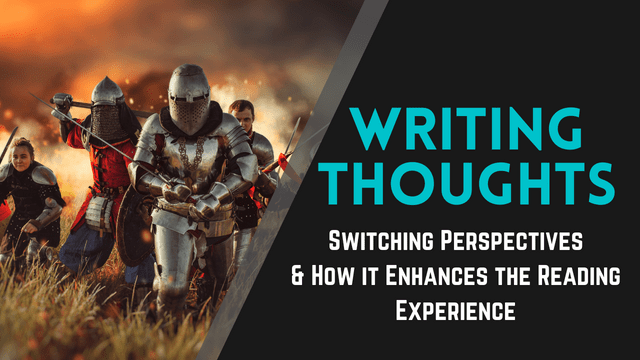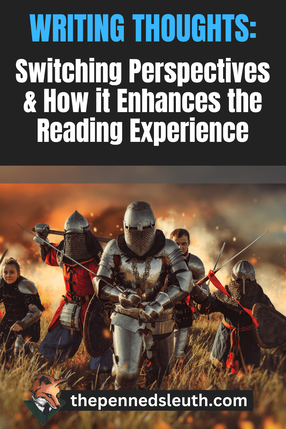Latest Writing Video! |
Writing Thoughts: Switching Character Perspectives & How it Enhances the Reading Experience1/20/2023 Switching character perspectives is a popular technique in writing used in all genres. While many novels today still like to stick with a single character’s perspective, having multiple characters to bounce between has its benefits. Here is why I think it enhances the reading experiences of most novels. Let’s dive in! Pin for Later!The TopicNow, most novels will focus on several main characters with a primary character being the perspective from which the reader sees the world. The benefit of following a single character is that you know that the story is for them more than it is for the other characters. It is this character that will face most of the challenges, developing over the course of the plot, and hopefully, the reader builds an attachment to them. The tactic for most writers sticking with a single main character is to give them a more agreeable, plain personality rather than an eccentric one. At least, this is a tactic employed by writers when they plan on creating a lengthy novel, or series. It gives more attention to the diverse range of characters in the stories, rather than having the main character overshadow the personality of the other characters. However, switching perspectives works well with larger stories with larger world spaces. It gives the reader different perspectives, different thoughts, and ambitions. The world immediately feels larger, and more alive, with many characters working to achieve their own goals while having more unique personalities. And this switching of perspectives can work in two ways. One, the writer can follow these different characters through third-person narration. While third-person narration can still strictly align itself to the perspective of a singular character, it also makes managing the thoughts and ambitions of multiple characters easier. There doesn’t need to be a strong connection to a singular main character. The second way is through first-person character switching. The characters are directly narrating what they experience and because they refer to themselves in the first person, some specification of which character is speaking may be required. Whether you use the third or first-person method, it will still offer the reader a better understanding of the characters and the world space than if you were to focus entirely on the perspective of a single character. My ThoughtsMy first encounter with such a story was an indie novel I read many years ago. The title escapes me despite all my google searches, but the story doesn’t. It follows six characters who fall asleep and find themselves in a different dimension where they have powers and a responsibility to protect average people from the forces of darkness. Every new chapter was a perspective change. Six characters, six perspectives to cycle through every six chapters. There was another novel I read, absolutely awful, so I am not going to mention the name although I remember it. It had three main characters, different perspectives, and at different times. The technique was well executed even though the story was poor. Either way, both had a big influence on my first novel, The Four Horsemen, which had four main characters and I switched between their perspectives every chapter. My first draft focused on one character initially, following his perspective and all of his encounters throughout the story. However, the first draft felt like it lacked depth and the other characters were almost begging for more attention. So, I dabbled with some ideas, then I restructured the plot, and then rewrote the book, omitting entire chapters so I could focus on different characters. Although I still feel like rewriting much of my first book, the different perspectives made that novel several times better than what I had initially. I found myself enjoying the different characters. Before, I had to make sure that a singular main character was present for all the major points in the novel, such as the development of the plot or a specific character. I had more freedom to develop both the plot and characters, even if they were alone for a chapter. As a writer, you can include more scenes in your novel where the next character feels equally as important as the last. You and the reader can better differentiate between the characters as switching perspectives forces you to create more fleshed-out personalities. That diversity has one shortfall and it’s the possibility that a reader won’t be interested in certain characters, but that is a shortfall that I believe is easily looked over if their side of the story is interesting. Now, having four or more characters sounds like a lot to work with despite all the benefits these multiple perspectives lend to the story, but you can get a lot of the same benefits by just working with two characters. A reader can truly appreciate the differences in your characters when you switch the spotlight from one to the other. With that said, if you have been considering alternating between characters' perspectives, or simply including a different perspective for a chapter or two, I can highly recommend you do so. The readers will benefit, the world space will benefit and if you’re anything like me, you will enjoy the writing experience of working with different perspectives! ConclusionWhile I happily sing praises about this storytelling technique, I know that some stories are simply designed to focus on the perspective of one character. Genres like fantasy and science fiction, especially ones with large world spaces, can make good use of this technique.
However, for more down-to-earth stories in genres like thriller or mystery, focusing on a singular character's perspective and emotional state can be crucial to the atmosphere and the plot. I would love to hear your thoughts on this topic! Do you enjoy reading stories with multiple perspectives? Or do you think I praise this technique too much? Let me know in the comments! Thank you for reading and as always, Good day, goodnight, and happy writing!
0 Comments
Leave a Reply. |







